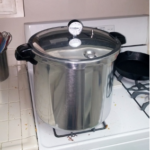Time to Check Canning Equipment
go.ncsu.edu/readext?857211
en Español / em Português
El inglés es el idioma de control de esta página. En la medida en que haya algún conflicto entre la traducción al inglés y la traducción, el inglés prevalece.
Al hacer clic en el enlace de traducción se activa un servicio de traducción gratuito para convertir la página al español. Al igual que con cualquier traducción por Internet, la conversión no es sensible al contexto y puede que no traduzca el texto en su significado original. NC State Extension no garantiza la exactitud del texto traducido. Por favor, tenga en cuenta que algunas aplicaciones y/o servicios pueden no funcionar como se espera cuando se traducen.
Português
Inglês é o idioma de controle desta página. Na medida que haja algum conflito entre o texto original em Inglês e a tradução, o Inglês prevalece.
Ao clicar no link de tradução, um serviço gratuito de tradução será ativado para converter a página para o Português. Como em qualquer tradução pela internet, a conversão não é sensivel ao contexto e pode não ocorrer a tradução para o significado orginal. O serviço de Extensão da Carolina do Norte (NC State Extension) não garante a exatidão do texto traduzido. Por favor, observe que algumas funções ou serviços podem não funcionar como esperado após a tradução.
English
English is the controlling language of this page. To the extent there is any conflict between the English text and the translation, English controls.
Clicking on the translation link activates a free translation service to convert the page to Spanish. As with any Internet translation, the conversion is not context-sensitive and may not translate the text to its original meaning. NC State Extension does not guarantee the accuracy of the translated text. Please note that some applications and/or services may not function as expected when translated.
Collapse ▲ April is the time to get out your canning equipment and make sure you are ready for the canning season. Before you know it, fresh produce will be available to preserve for use during the colder fall and winter months.
April is the time to get out your canning equipment and make sure you are ready for the canning season. Before you know it, fresh produce will be available to preserve for use during the colder fall and winter months.
Here is a check list for you to follow:
- Check your canners for any damage or needed replacement items. If you have a Presto brand gauge canner you should check your gauge to make sure it is reading accurately each year. We can do that with an appointment in our office. If you are not sure if your canner is a type we can check, please call us and Cathy Hohenstein can figure this out with you. You also want to make sure all the rubber gaskets and stoppers are in good condition. We are here to help so, contact us if you need us
- Check your jars out to make sure that they do not have chips, cracks or nicks that can lead to jar breakages or ending up with jars not getting a good seal.
- Check for any updated recommendations. Look for our facebook weekly posts to see if there are changes to your favorite recipes due to new safety knowledge and for announcements for seasonal hands on canning and preserving classes.
- You can start storing up on new lids and jars slowly over the next few months as you see sales or availability. The past few years we have run into scarcity with jars and lids during heaving canning months.
- Look for the announcements of our Food Preservation classes this year. We will have some in-person classes and online classes, which will include canning, freezing, dehydrating and pickling.
For more information about safe canning and safe recipes, go to NCSU Safe Plates: Canning Fact Sheet or National Center for Home Food PreservationYou can also contact Cathy Hohenstein, FCS Agent through our office at (828) 652-8104 or email at cathy_hohenstein@ncsu.edu. She is available to meet and share more information and you can make an annual appointment to get your pressure canner dial gauges checked for accuracy.




